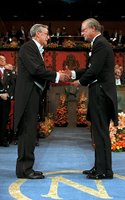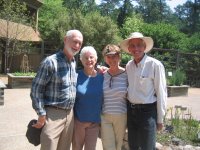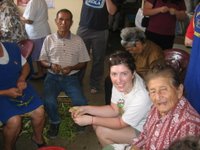Professor Rosenthal is "Only Inches Away from a Nobel Prize"
We Dodge a Bullet
Since the last posting, I passed the one year mark of knowing I am living with cancer. It has been a wild, wild ride, including the last week. The ride is not over yet. I wish I wasn’t tired so much of the time. I am sick and tired of being sick and tired, but I’m very grateful to feel a lot better than a year ago.
We had a huge scare last week. For three days, I had a constant dizzy feeling like motion sickness or the light-headedness you sometimes get for a minute after standing up too fast. It started on a Saturday, when Roger was off duty. Though he probably would not have minded my calling him at home, I called his partner on call, Dr. John Hausdorf. John spoke to me both Saturday night and Sunday night. He was very much aware of my case and had pondered a lot about the spleen mystery last fall. Like Roger, John is smart, compassionate, non-egotistical and an excellent communicator. We agreed it was better for me not to go the emergency room and to wait and see Roger on Monday morning, when I already had an appointment. He said the imaging technology available on weekends is not as good as on weekdays.
It took a while for the words “imaging technology” to sink in and make me realize he was thinking about brain tumors.
Roger's intuition on Monday morning was that I had benign positional vertigo. (How I love that word benign!) He prescribed two things. The first was an appointment with an ear-nose-and-throat specialist (ENT) to look into this hypothesis. The second was a brain scan by MRI to rule out something much worse. If the vertigo theory was correct, he said, the condition would probably go away on its own.
To my pleasant surprise, Roger did not cancel my chemo for Monday. He made one modification, postponing one ingredient of the chemo cocktail, Avastin. It’s a relatively new monoclonal antibody, which could not be immediately ruled out as a cause of the dizziness. Avastin is an unlikely culprit since the onset of this dizziness occurred three weeks after chemo. I think a far more likely scenario is that it was a result of a strenuous (for me) physical therapy I did on a treadmill the day before the dizziness started. (I was just walking on the treadmill, a far cry from my running and backpacking days, but I managed to double my heart rate, probably for the first time in over a year.)
So what a day that Monday was! First the exam by Roger, then chemo, then some Nobel-inspired neuropathy therapy for my feet (more on that later). Then to the hospital for the brain scan. The MRI was delayed two hours because they needed to find an oncology nurse to temporarily disconnect the portable chemo pump that I wear for 24 hours after chemo infusion. I was too dizzy to drive, so Pascale did more driving than a soccer mom. I really needed her support, both physically and emotionally. I was quite a basket case –with the wild steroid rush from the chemo cocktail, some incidental indigestion, the zing in my feet from the neuropathy therapy, the foreground of dizziness, the background of major anxiety about the possibility of brain tumor, and the utter exhaustion of a noisy, claustrophobic half-hour with my head in the barrel of an MRI machine. The only thing that kept me from going crazy in the barrel was saying praises for the good fortune of having so many people pulling for me.
The brain-scan technician said the radiologist would view the MRI and report his findings to Roger the next day. So Pascale and I went home and sat with our worries and my bonkers combination of steroid speediness and dizzy tiredness. I was trying to get distracted by NBA basketball playoffs, and Roger called during the game, at almost 10pm. He had heard from the radiologist that night, who said there were no abnormalities in my brain! (Hey, even if you are thinking you don’t agree with him, please don’t argue now.) Roger was so great to call rather than let Pascale and me go to sleep worrying. We were overjoyed and so, so grateful.
Later in the week, I saw the ENT whom Roger recommended, Dr. David Awerbuck. By coincidence, I knew David and had just run into him for the first time in five years at the synagogue, the night before the onset of the dizziness. We had a great chat, mainly about kids, because his lovely son and four other cute, smart seven-year-olds were assisting with the Sabbath service. He told the story of the great physicist Isadore Isaac Rabi, who was once asked why he became a scientist rather than a doctor. Every night before he went to bed, Rabi’s mother would ask not what he had learned in school that day but whether he had asked a good question. It was so natural to become a scientist, Rabi said, because he had been encouraged to ask questions.
When I saw Dr. Awerbuck in the office, the dizziness was almost gone and he attributed it to the vertigo that Roger suspected. He said it could have been brought on by an ear infection or by the dislodging of a crystal in the inner ear when I was pushing hard on the treadmill. We will probably never know. It doesn’t matter. A major bullet has been dodged.
Inches Away from the Nobel: Robert Furchgott and Neuropathy Therapy
So what’s my connection to the Nobel Prize? It turns out that Robert Furchgott, a third-cousin of my mother and close friend of the family, is co-winner of the 1998 Nobel Prize in Physiology or Medicine. He won for "discoveries concerning nitric oxide as a signaling molecule in the cardiovascular system." [http://nobelprize.org/medicine/laureates/1998/furchgott-autobio.html]. His discoveries in basic science enabled others to develop Viagra, for example. Bob is an extremely soft-spoken and modest man, not in the least interested in the financial ramifications of his work. After the prize, the elected supervisor of the town in New York where he (and my parents) lived wanted to erect a sign, “Home of a Nobel Prize Winner” with Bob’s name on it. Bob’s modesty would not allow that, but of course it did not slow down the politician. The supervisor put up the sign anyway, with his own name on it. (Bob is generous about lending his name in other ways, for example writing an inspiring letter to Marjorie’s middle-school science class.)
A few months after receiving the prize in Stockholm, Bob came to my parents’ house for dinner while I was visiting. He brought his Nobel gold medal and a scrapbook that the Nobel committee had given him. (He was allowed to bring 12 family members for the ceremonies and banquets.) My Mom took a picture in my parents’ screen porch of Bob and me. He is holding his gold medal. I have this picture on my office door with the caption, “Professor Rosenthal is only inches away from the Nobel Prize.”
Seven years later, Bob is 90 and retired to his birthplace, Charleston, South Carolina. I am still a professor who is a million miles away from a Nobel, though with a new focus: fighting cancer. I just started seeing a physical therapist for a condition in my feet called peripheral neuropathy. This deterioration of nerve endings in the extremities is common in chemo patients. It is more severe and common in diabetics. For me, it is not painful, just a constant feeling of partial numbness on the bottom of my feet. It’s minor, like having sand in my shoes, but my niece Jessica warned me last year that it might be coming, and that in some cases it can get bad enough to interfere with the continuation of chemo. I mentioned to Roger that it is getting more pronounced, and he sent me to the PT, Christie Doyle.
Christie is the only person in our area who offers Anodyne therapy for neuropathy. In our first session she explained that infrared light would be aimed at my feet for 45 minutes, and this would stimulate the production of nitric oxide in my red blood cells, which would stimulate the rejuvenation of capillaries around the withered nerve endings and would ultimately allow the nerve endings to grow back. She said there was a fairly recent Nobel Prize awarded for the science upon which this new therapy is based. Guess who did the science? Bob Furchgott had not only worked out the nitric oxide connection, he also discovered that light (especially infrared) could stimulate NO production. In other words, I get Viagra for the toes. (The only difference is it’s not delivered by a pill. Clamping infrared lighting to the organ effected by Viagra is not a feasible option.) My neuropathy treatment is all thanks to the genius of a dear friend of the family, a pure scientist who doesn’t know yet he is part of my fantastic team.
Spleen Enlargement Finally Explained
Roger went to an oncology conference recently at which he discussed my case with several colleagues. He came home very excited, saying he now understands what caused my spleen enlargement. The liver must have had an inflammatory reaction to one of the chemo medicines, and this stimulated the spleen to overwork. Jessica adds, “As the liver was regenerating from the destruction of the tumors, the vascular flow was altered and it caused a back up in the spleen. This caused the spleen to enlarge. Because you were on the chemo for so long, the growth of the spleen and the inflammatory reaction in the liver persisted longer than doctors had seen in the past (when the chemo drugs weren't nearly as effective as they are today).”
As a non-oncologist, I find this explanation anticlimactic, even though Roger says he will present my case at a future oncology conference. I cannot appreciate what is unusual and surprising here, but I'll be proud of my contribution to knowledge as his specimen.
Travel
Pascale and I took a week-and-a-half trip to Chapel Hill, North Carolina and Miami. The primary purpose of the Chapel Hill visit was to see my old friends Judy and John Philpot. They had never met Pascale. I had told her about the Philpots, and vice versa, singing so many praises on both sides that they were wary to meet one another in the flesh. It turned out to be a wonderful visit – along with joining together in teasing me about my potentially intimidating habit of putting the people I love on pedestals a mile high, John and Judy got along famously with Pascale. We thoroughly enjoyed their hospitality in the colorful North Carolina springtime. It had been much too long since seeing these dear friends.
Before planning the trip to Chapel Hill, I remembered hearing the story from Terry and Penelope Connolly about the 90th birthday celebration of a person they knew. She was asked if she harbored any regrets in her long life. She had been beaten and jailed in the civil rights movement, but had no regrets about that. Her only regret was not having taken the time to visit friends in far places when her health and finances would have allowed. If your health allows, take my advice: go see your friends and family. It is worth any amount of money.
I had a guest lecture gig at North Carolina State University, hosted graciously by my friend Jim Wilson. It was a lot of fun. Grad students and faculty seemed to appreciate the ideas, and Jim snuck into the room one of those kindergarten teacher's stools so I did not have to stand the whole time. It is a great prop, because I could stand up on occasion to emphasize a point.
The trip to Miami was to attend an INFORMS conference on practical applications of operations research. I had been involved in planning the conference in earlier years, but canceled my participation in 2005 at the last minute because it occurred the week after my diagnosis. It was so touching to be welcomed there by the many friends who knew why I had to bail out suddenly a year earlier.
A Meeting by the River
In the last blog posting, I recommended a movie. This time I’ll tell you about a book I just read, A Meeting by the River by Christopher Isherwood (1904-1986), published in 1967. It is an epistolary novel, told entirely through the letters and diaries of two brothers, Oliver and Patrick. They grew up in England, where Patrick has become a high-powered businessman and family man. Oliver turned his back early on a rising career in banking to become a Red Cross worker in Africa and then an ascetic monk in India. He is living in a Hindu monastery by the Ganges, and is about to take the highest vows a monk can take. The brothers resume contact after a long hiatus.
Isherwood’s language is incredibly beautiful and flowing. He puts you completely inside the heads of the brothers. There is no narrator or uninvolved observer, yet you can taste and feel the atmosphere as if you are with them. Isherwood poses probing questions in a non-preachy way about what are the real differences and similarities between the brothers’ diverse lifestyles? What is hypocrisy? Patrick makes me want to wring his neck, as he tells different versions of the same events to different people. But then as Oliver expresses his deepest uncertainties about whether he is worthy of elevation in the Hindu world, one can’t help but wonder is he being honest with himself? Are Oliver’s doubts about who he really is similar to Patrick’s? Maybe the two brothers represent different sides of Isherwood. Maybe the complexity and unresolved issues of their relationship represent conflicts inside the writer’s own mind. This is not a book for people who need intricate plot, but wonderful for people who are fascinated by the human psyche and love great writing.
Till next time, with all my love,
Rick
ps. John Birge was the only person who commented on the April Fool's joke in the last blog post (Scott Simon's description of the I-Bod). John is a famous OR professor at the University of Chicago. He also deserves to be known as an excellent humor writer.
Photos
My Mom's cousin and friend Dr. Robert Furchgott receives the 1998 Nobel Prize in Medicine from the King of Sweden.
Cousin Bob at my parents' house. Click on his hands to see the Nobel gold medal. 
Marjorie took this magical backlit photo of Claire and Skylar in March 2006. Are they the greatest, or what? The picture captures Claire's million-dollar smile perfectly.
Skylar contemplates the finer points of cheescake consumption on Claire's birthday.
John and Judy Philpot guide us through a beauthiful botanical garden in Chapel Hill.
Marjorie shells peas with the abuelas and an abuelo in a Peruvian hospice. I am so proud of her big heart.
Leslie Fine and Julie Ward, two good buddies from my sabbatical year at HP Labs, paid a sweet visit to our home and fixed a great gourmet lunch.
Abigail was recently signed by an acting/modeling agent. Agents work on commission so they don't take on new clients unless they think there is a chance of getting work. It is a very, very tough business. Abby is wise to keep her day job and stay in grad school. I remain her biggest fan and wish her luck.


0 Comments:
Post a Comment
<< Home